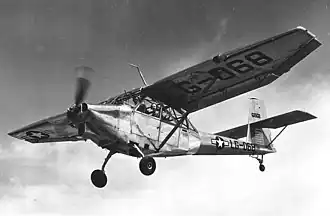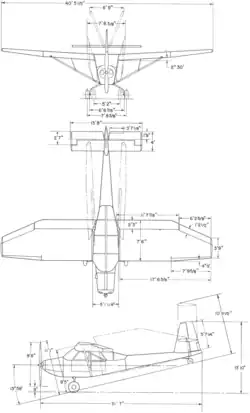Stinson L-13
| L-13 Grasshopper | |
|---|---|
 Note the windows in the roof giving excellent field of vision | |
| General information | |
| Type | Observation and Utility Aircraft |
| Manufacturer | Stinson Aircraft Company |
| Primary users | United States Air Force |
| Number built | 302 |
| History | |
| Introduction date | 1947 |
| First flight | 1945 |
The Stinson L-13 (sometimes known as the Grasshopper, like other aircraft of its type) is a US military utility aircraft first flown in 1945.
Development
The aircraft design was developed at Stinson in response to a request from the United States Army Air Force for a light observation/liaison aircraft. At that time Stinson was a subsidiary of Consolidated-Vultee. The first two prototypes were constructed at the Stinson facility in Michigan.[1] In 1948 the Convair board were restructuring their various units, and negotiated to sell the Stinson subsidiary to Piper Aircraft. The L-13 project was specifically not included in the assets of the sale, however, and Convair continued its production in-house; ultimately building 300 units as the Convair L-13.
It was a conventional high-wing tailwheel monoplane used for observation, liaison, and air ambulance duties, which typically require low landing speeds and short landing rolls. It was fitted with a large "greenhouse" to enhance its observation role.
Following their military service and resale into the private market, some units were converted for civil bush flying use, fitting a radial engine by Acme Aircraft Company as the Centaur, while others underwent similar conversions by Caribbean Traders Inc, as the Husky.[2]
Variants
- XL-13
- Prototype aircraft, powered by 245 hp (183 kW) Franklin O-425-6 engine. Two built.[3]
- L-13A
- Production aircraft, powered by 250 hp (187 kW) O-425-9 engine. 300 built.[3]
- L-13B
- Conversion of L-13A for cold weather operation, capable of operating from wheels, skis or floats. 28 converted.[4][5]
- Acme Centaur 101
- Conversion of L-13 as six-seat bush aircraft. Powered by 300 hp (224 kW) Lycoming R-680-E3.[2]
- Acme Centaur 102
- Similar to Acme Centaur 101, with a 300hp Jacobs R-755-A2 radial.[2]

- Caribbean Traders Husky I
- Civil conversion of L-13A. Retained O-425 engine.[2][6]
- Caribbean Traders Husky II
- Civil conversion of L-13A. Powered by 300 hp R-680-13 engine on modified engine mount capable of swinging out for easy maintenance.[2][6]
- Caribbean Traders Husky III
- Similar to Husky II, but powered by 450 hp (338 kW) Wright R-975-7 radial engine.[2][6]
- Servicair Loadmaster
- Reconstruction of L-13A with 450 hp Pratt & Whitney R-985-AN-1 radial engine and rearranged four-seat cabin.[7]
Operators
- United States Air Force
- United States Army received 43 ex-Air Force L-13As following the outbreak of the Korean War, serving in the Continental United States to free up aircraft for active service overseas.[8]
Surviving aircraft
Brazil
- 47-406 – L-13 on display at the TAM Museum in São Carlos, São Paulo.[9]
United States
- 46-159 – L-13A in storage at the United States Army Aviation Museum at Fort Novosel near Daleville, Alabama.[10]
- 47-275 – L-13A on display at the Arkansas Air and Military Museum in Fayetteville, Arkansas.[11][12]
- 47-287 – L-13A in storage at the Castle Air Museum in Atwater, California.[13][14]
- 47-316 – L-13A airworthy at the War Eagles Air Museum in Santa Teresa, New Mexico.[15][16]
- 47-355 – L-13 on static display at the Pearl Harbor Aviation Museum in Honolulu, Hawaii.[17][18]
- 47-394 – L-13A on static display at the Planes of Fame Air Museum in Chino, California.[19][20]
- 47-412 – L-13B airworthy at the Heritage Flight Museum in Burlington, Washington.[21][22]
Specifications (L-13A)

Data from General Dynamics Aircraft and their Predecessors [23]
General characteristics
- Crew: 1
- Capacity: 2 passengers
- Length: 31 ft 9 in (9.68 m)
- Wingspan: 40 ft 5+1⁄2 in (12.332 m)
- Height: 8 ft 5 in (2.57 m)
- Wing area: 270 sq ft (25 m2)
- Empty weight: 2,070 lb (939 kg)
- Gross weight: 3,185 lb (1,445 kg)
- Powerplant: 1 × Franklin O-425-9 air-cooled flat-six engine, 250 hp (190 kW)
Performance
- Maximum speed: 115 mph (185 km/h, 100 kn)
- Cruise speed: 92 mph (148 km/h, 80 kn)
- Range: 368 mi (592 km, 320 nmi)
- Service ceiling: 15,000 ft (4,600 m)
- Rate of climb: 830 ft/min (4.2 m/s)
See also
Aircraft of comparable role, configuration, and era
References
Notes
- ^ Jason McDowell (29 November 2022). "History's Unique Aircraft: The large, slow-moving shadow of the Convair L-13". Flying/Daily Newsletter. Retrieved 5 December 2022.
- ^ a b c d e f Wegg 1990, pp. 180-181.
- ^ a b Wegg 1990, p.180.
- ^ Harding 1990, p.92.
- ^ Swanborough and Bowers 1963, p.489.
- ^ a b c Flight 9 September 1955, p. 466.
- ^ Taylor 1961, p. 316.
- ^ Harding 1990, pp. 91-92.
- ^ "Airframe Dossier - Convair L-13, s/n 47-0406 USAF, c/n 286, c/r N4236K". Aerial Visuals. Retrieved 4 December 2022.
- ^ "Our Collection". United States Army Aviation Museum. Retrieved 14 December 2024.
- ^ "Aircraft". Arkansas Air and Military Museum. Retrieved 4 December 2022.
- ^ "Airframe Dossier - Convair L-13A, s/n 47-0275 USAAF, c/r N275LG". Aerial Visuals. Retrieved 4 December 2022.
- ^ "Aircraft on Loan (by Location)" (PDF). National Museum of the United States Air Force. April 2016. Retrieved 4 December 2022.
- ^ Baugher, Joe (30 June 2021). "1946-1948 USAAF-USAF Serial Numbers". Joe Baugher's Home Page. Retrieved 4 December 2022.
- ^ "L-13". War Eagles Air Museum. Archived from the original on 19 May 2022. Retrieved 4 December 2022.
- ^ "FAA Registry [N316LG]". Federal Aviation Administration. U.S. Department of Transportation. Retrieved 4 December 2022.
- ^ "Stinson L-13 Grasshopper". Pearl Harbor Aviation Museum. Retrieved 4 December 2022.
- ^ "Airframe Dossier - Convair L-13, s/n 47-0355 USAF, c/r N2536B". Aerial Visuals. Retrieved 4 December 2022.
- ^ "Stinson L-13A 'Grasshopper'". Planes of Fame Air Museum. Retrieved 4 December 2022.
- ^ "Airframe Dossier - Convair L-13A, s/n 47-0394 USAAF". Aerial Visuals. Retrieved 4 December 2022.
- ^ "L-13 Grasshopper". Heritage Flight Museum. Retrieved 4 December 2022.
- ^ "FAA Registry [N7412]". Federal Aviation Administration. U.S. Department of Transportation. Retrieved 4 December 2022.
- ^ Wegg 1990, p.182.
Bibliography
- "Convair Conversion." Flight, 9 September 1955, p. 466.
- "Plane With Folding Wings Can Be Towed Like A Glider" , March 1947, Popular Mechanics rare photos of L-13 folded for towing by jeep
- Davisson, Budd (August 1990). "Convair L-13: The Box It Came In". Air Progress. Retrieved 4 December 2022.
- Harding, Stephen. U.S. Army Aircraft Since 1947. Shrewsbury, UK:Airlife, 1990. ISBN 1-85310-102-8.
- Swanborough, F.G. and Bowers, Peter M. United States Military Aircraft since 1909. London:Putnam, 1963.
- Taylor, John W. R. Jane's All the World's Aircraft 1961–62. London: Sampson Low, Marston & Company, Ltd., 1961.
- Wegg, John. General Dynamics Aircraft and their Predecessors. London:Putnam, 1990. ISBN 0-85177-833-X.